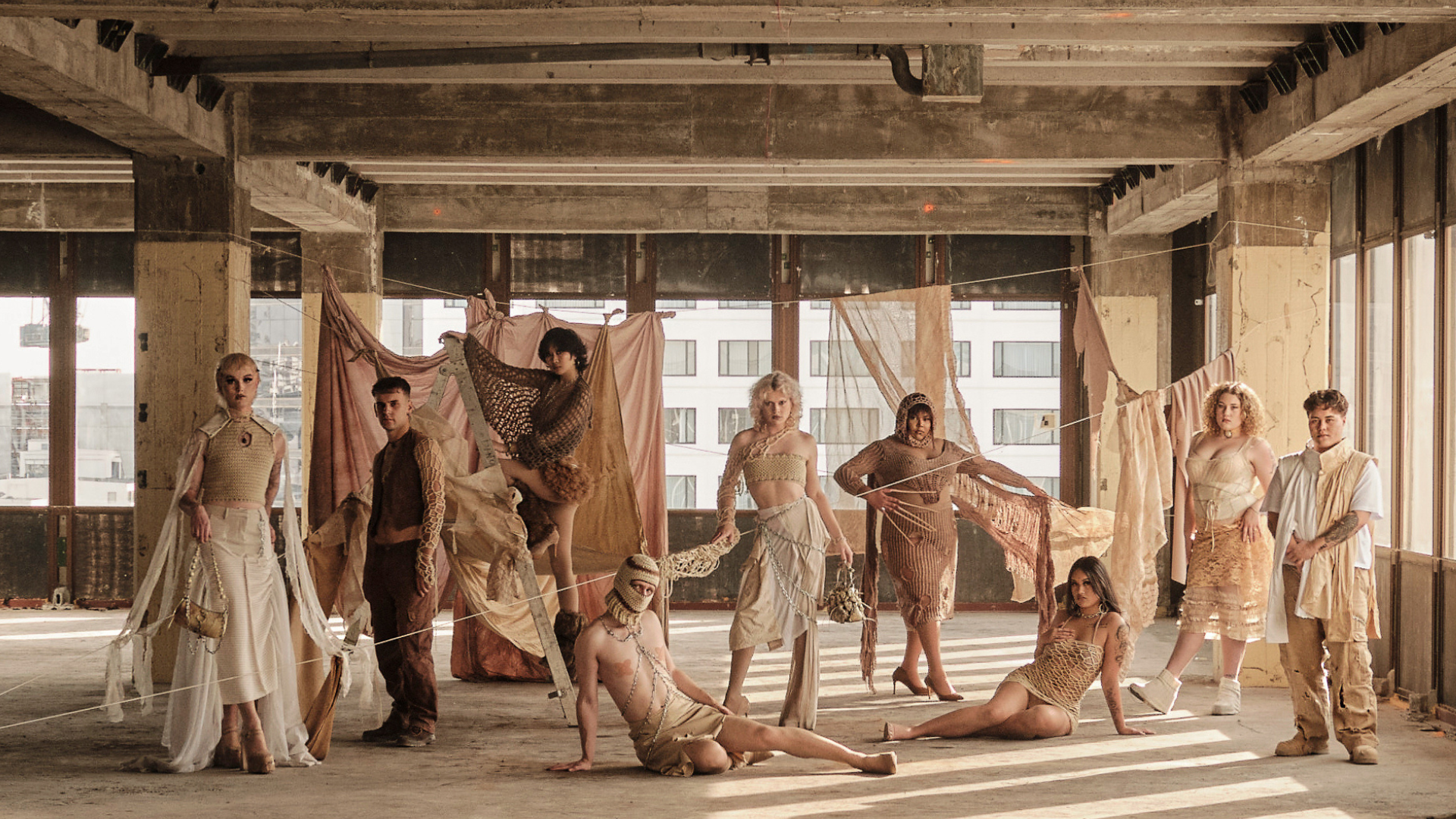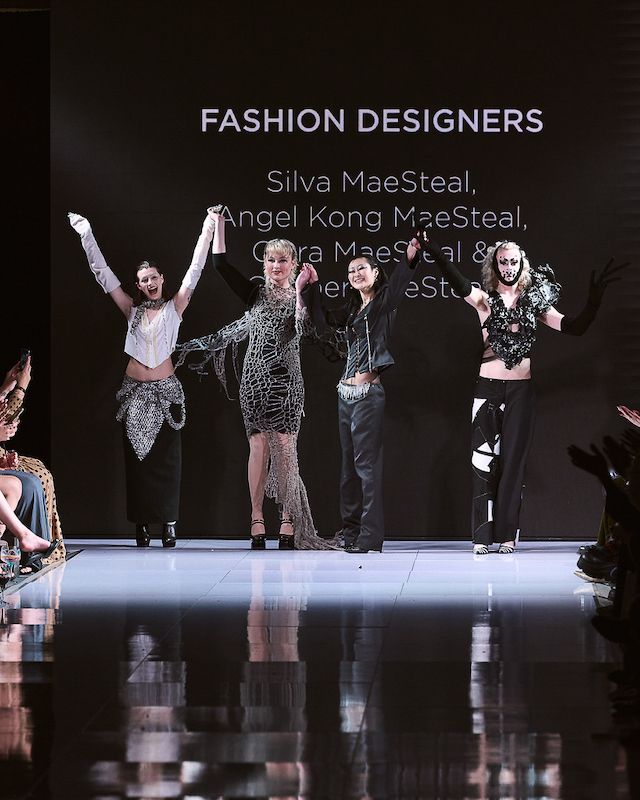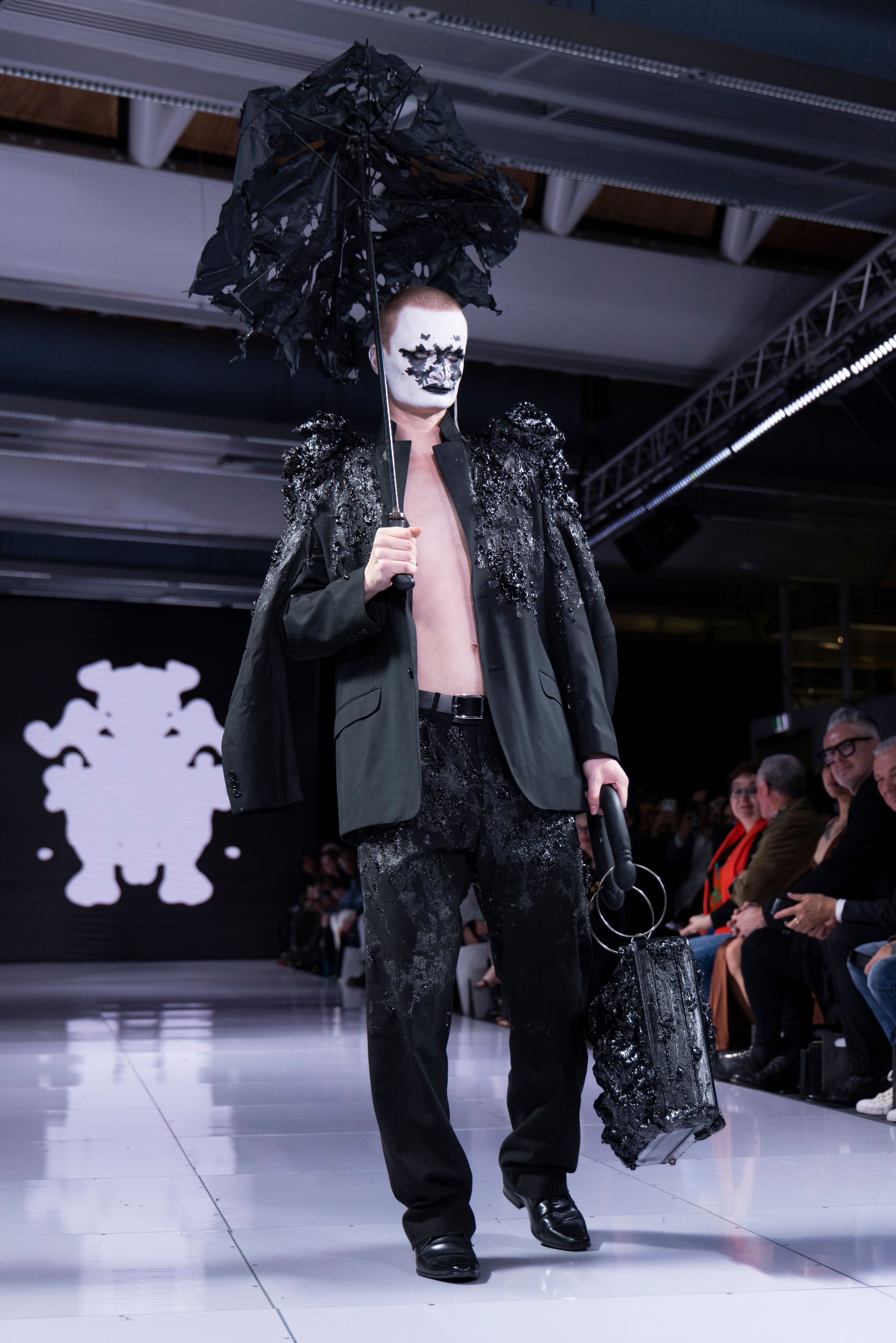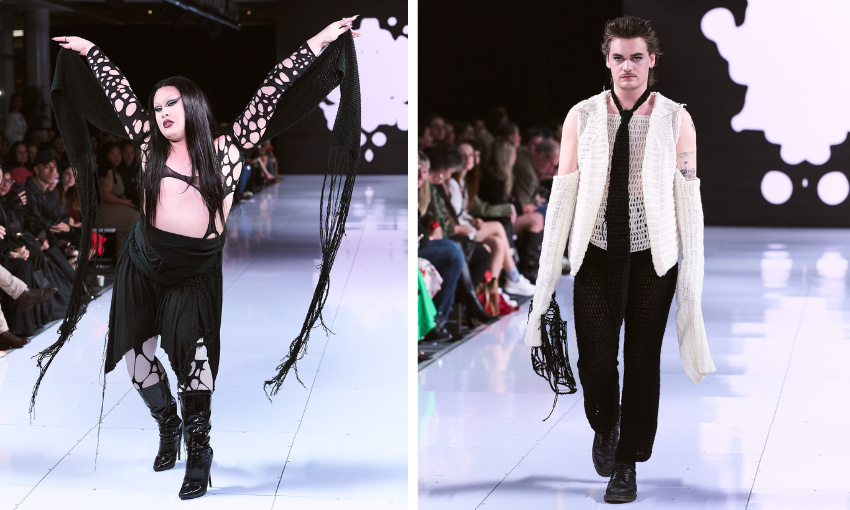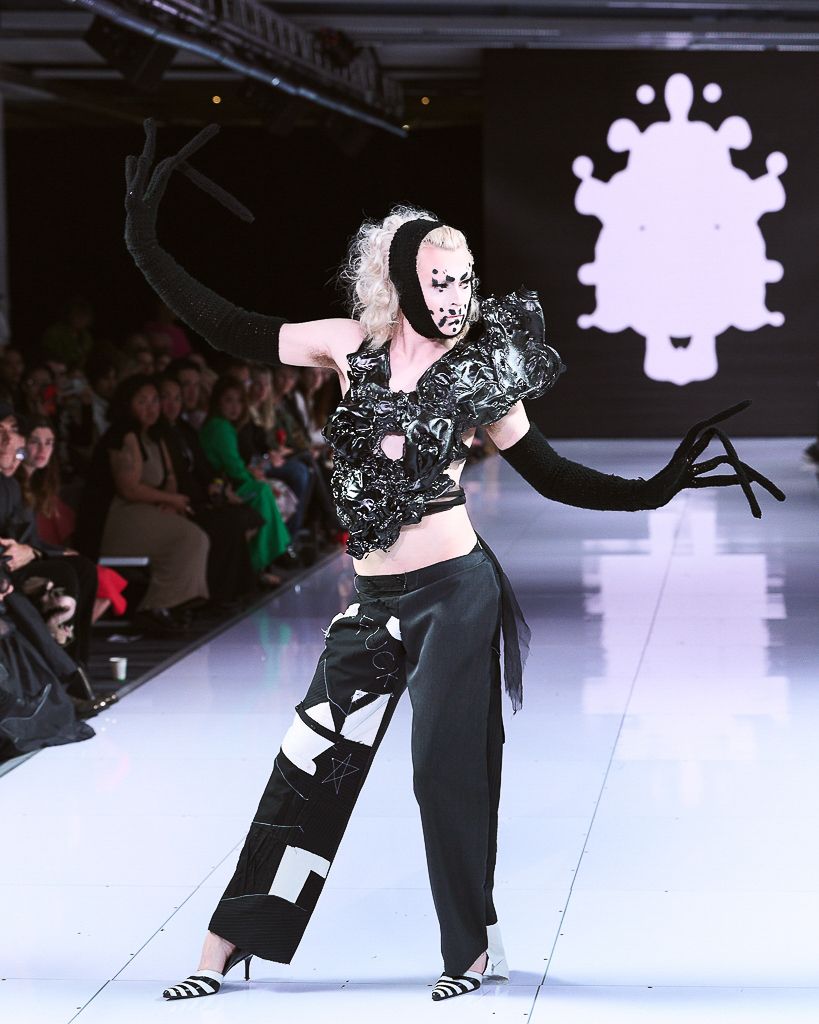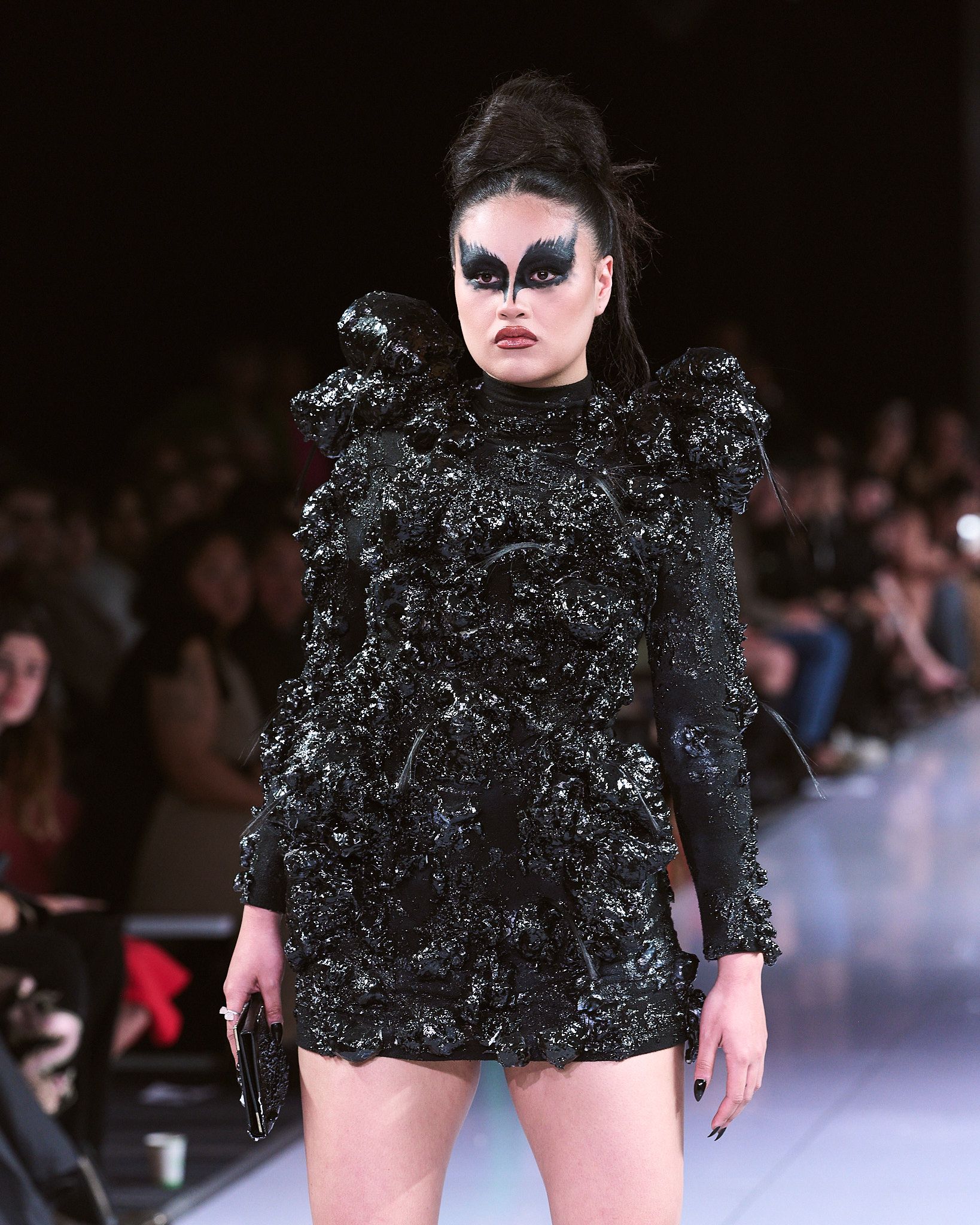Rebirth and Renewal: A Response to MaeSteal
MaeSteal Collective was among the most hyped shows for fashion week. Naomii Seah recaps and analyses the closing show of NZFW: Kahuria and sits down with some of the artists.
“You’re now entering work for the first time. It can be fun, or it can be hard. It all depends on the way you look at things.”
So begins MaeSteal Collective, the closing show of New Zealand Fashion Week: Kahuria (NZFW). It’s the first Fashion Week to be held in four years, and the room is packed. Soon it’s standing room only and the energy of the crowd is palpable.
On the screen behind the catwalk, inkblots fuse together and split apart. At times they look like insects. At other times, two symmetrical black spots against the white look almost like eyes, the image vaguely human.
The woman’s voice – a sample from a 1950s instructional video – skips a beat and blends into a techno backing track as the show begins.
MaeSteal Collective is a young and nascent group of artists. In an interview with Rat World, Founder Copper MaeSteal (he/she) describes them as “a group of friends wanting a queer arts group to hang out with.” The group was officially founded in mid-July, making the Collective only two months old.
The artists of the Collective are diverse in medium and identity; their backgrounds range from drag to theatre to music to visual arts and sculpture. Many of the artists took up the last name MaeSteal, adopted from Copper’s drag name. It’s a nod to ballroom culture, where houses are found families that provide support for Queer kids who may have been rejected by their biological families. Adopting the MaeSteal name, then, is not only a way for the collective to be immediately linked together, but also a way to acknowledge the group’s ties to the Queer community, and especially Queer communities of colour.
On the NZFW website, the collective is described as “explor[ing] personal identity, destruction, and human perspective” in their work. It continues:
This year, MaeSteal will bring audiences a production that encapsulates the queer body in a state of distress and anxiety. They aim to showcase the ‘abnormal’, ‘strange’ and ‘bizarre’, as a means to reclaim the origins of the word ‘queer’ within their designs. Untangling classically gendered silhouettes and business attire, creating each piece ranging from avant-garde distressed wear to creature wear.
At NZFW, MaeSteal’s diverse talents meant these themes were explored from every angle – from the audio-visual to the designs themselves, some of which were akin to wearable art.
The audio-visual was the work of Stain MaeSteal (he/him), a music producer, photographer, sound and visual designer, and drag artist. In collaboration with Copper and the other designers, Stain produced the backing track by remixing samples from 1950s instructional videos into an electronic techno-mix that accompanied all the designs.
“We knew what sounds we wanted to play off, so it was a process of having discussions with Stain of what we wanted, and then leaving him to do his magic and then offering feedback,” says Copper. “Stain does a lot of techno music, trap beats, producing three-minute clips. So to produce a half-hour track was a huge jump. Everyone who worked on this project really pushed themselves to do something they hadn’t done before.”
MaeSteal principle designers (Photography by Ryan Patrick).
Angel and Copper explained that although the collective is composed of ten artists, four were the principal designers for the NZFW show, though the process of coming up with the looks was intensely collaborative.
Clara MaeSteal (she/her) is a designer who works mainly with patterning tailored silhouettes. Silva MaeSteal (she/they/he) works with very tight-knit, bound crochet, and Angel MaeSteal (she/he), founder of the brand KONGCORE, has a more distressed style of crochet. Angel also contributed to the detail work in the looks, with wire and beading and pinning. Finally, Copper’s contribution included more sculptural, wearable-art pieces. “We all had different skill-sets but we all collaborated and helped each other. We used the same mediums and materials to work on clothing but in our own way,” says Angel.
The show started with its most obviously work-wear-inspired looks. Suits of soft crochet and cut-outs were sent down the runway, as well as office shirts pinned into a Vivienne Westwood-esque gown. Among my favourite looks was the suit modelled by Tiger MaeSteal (he/him) – the collective’s photographer and videographer.
As Tiger approaches, the audience can see that an otherwise conservative pinstriped suit jacket and pressed grey slacks have been burned and slashed. When he turns around, you can see the jacket has the shape of a cross burned into it, perhaps a reference to the theory of capitalism as religion. This posits that capitalism is akin to religion because it outlines a series of fundamental principles and values that guide the individual as they make decisions.
Suits of soft crochet and cut-outs were sent down the runway, as well as office shirts pinned into a Vivienne Westwood-esque gown.
As well as the clothes being literally ‘in distress’, the process of upcycling also means the normal and mundane office suit becomes provocative and new. These themes of rebirth and renewal are not only a reference to the Queer community, but also to sustainability – a key theme of this year’s NZFW. It’s a topic the entire industry has been grappling with as fashion continues to be one of the worst-polluting industries, responsible for ten percent of global emissions. And MaeSteal knows this. Several of their designs feature motifs that look like mould and fungi, referencing rot and decay. It’s a challenge to the way we view ‘waste’ – when do fabrics and materials become trash?
“We tried to be ethical in a lot of ways and sustainability was a big part of it,” says Angel. Fabric for the collection was sourced from the collective’s own wardrobes, as well as from op shops and free clothing found elsewhere. They mostly utilised old business-wear, upcycling the garments to make the collection.
Photography by Ryan Patrick
This spirit of recycling and repair directly contradicts the consumerist culture that became prominent throughout the 1950s, which encouraged a linear model of consumption – the idea that products we use have a finite life before they are discarded. The show then juxtaposes the audio against the designs, suggesting a critique of consumer capitalism. In direct response to the symbiosis of capitalism and consumerism, Copper recounts using an old umbrella in Stain’s look. “That umbrella was my dad’s old umbrella from an old office building for a company that went bankrupt. I thought it was perfect to destroy and go with the look, and the symbolism of its story fit so perfectly on our runway.”
Copper says he wanted to highlight the origins of the word ‘Queer’ as showcasing the ‘bizarre’ and ‘unusual’, as a way to express the alienation of Queer bodies. The exaggeration of the human form, then, is a way to play on the Queer experience. “I get a lot of inspiration from other artists that take the human body and put it back into this original ball of flesh. It makes you ask, ‘What is a human? How do we interpret the human form?’”
Photography by Felix Jackson
The question is ever present in the collection. In several looks, sleeves extend and trail behind the model, giving the appearance of extra-long arms. Elongated fingers are also featured, including one look worn by Copper. In Stain’s look, extra sleeves are sewn into the jacket.
Photography by Ryan Patrick
Inkblot makeup is reminiscent not only of the pathologisation of Queerness in the 1950s by the psychiatric institutions, but also of butterflies, insects, non-human beings. Dramatic eyeliner reminds the audience of the little green men of the 50s, and the pale bases and exaggerated features are yet another nod to drag.
Photography by Ryan Patrick
Other looks feature sex toys of polished black latex used as bag handles, and other kink and fetish elements. One suitcase handle is made of a double-ended dildo. “I’d say, within the media, the Queer body is oversexualised,” Copper comments. He explains that these handles comment on this oversexualisation by desexualising objects. After all, the toys are simply silicone – it’s only in our human interpretation that objects assume sexual connotation. By presenting the object again as simply a bag handle, MaeSteal desexualises it.
The group says they also wanted to divorce the Queer image from the rainbow. Copper notes that the rainbow is a Queer symbol that has been increasingly co-opted by corporations, divorcing it from its original context. Now, a rainbow can be seen as a shorthand for the happy, corporate and commercial version of Queerness. That’s why MaeSteal have kept the collection to a tonal colour palette, conveying stress and anxiety not just in material but in the black, white and grey of the hues.
Gendered professional standards are just some of the codes used to enforce conformity and punish differences under capitalism.
Gender norms are another area that the collective touch on. Copper notes that gendered professional standards are just some of the codes used to enforce conformity and punish differences under capitalism. “We wanted to talk about … the bigotry behind those standards.”
In the collection, several looks defy gendering. A little black dress – traditionally one of the most feminine-coded garments – is padded with expanding foam that subverts the male gaze by playing on the female silhouette. The dress is constructed of protrusions: sexualised aspects of the female form like breasts and bums become just more lumps in its silhouette. On closer examination, you can see hairs sprouting from the fabric, playing on gendered expectations of grooming.
Photography by Ryan Patrick
The call-backs to the 1950s aren’t just aesthetic, but political. Anti-capitalism, environmentalism and Queerness are tied together in MaeSteal’s collection. Given these messages, the irony of working with NZFW – an incorporated business with a profit-driven agenda – is not lost on MaeSteal Collective. “NZFW is very corporate, very commercialised… a lot of what we are doing is trying to go against the grain. It’s a bit of an f-you to wear literal rubbish down the runway,” says Copper. “We’re so grateful for this opportunity, but because we’ve infiltrated the event, we wanted to put everything we don’t like about corporations and industry onto the runway. It’s kind of a protest against NZFW in a way,” adds Angel.
The designers shout-out Rogue Aotearoa specifically, who put on their own runway ahead of NZFW due to the cost of participating in the official event. As young designers, Kat Aucamp and Billy Blamires felt NZFW was inaccessible because of the expense. Rogue Aotearoa was born from this need – it’s a DIY show put on by emerging designers, outside of the official NZFW schedule. The show was sold out, signalling the public’s hunger for young and new designers. And perhaps it signals something else, too: that NZFW still represents an elitist industry where well-established designers and big names are given priority as they’re guaranteed to sell seats.
NZFW still represents an elitist industry where well-established designers and big names are given priority
Still, NZFW has come a long way since its inception in 2001. This year’s show saw a partnership with Ngāti Whātua Ōrākei as well as a greater focus on inclusivity and diversity. This year’s offering saw the first dedicated Pacific showcase, and shows themed around sustainability and digital technologies. In media releases and other promotional materials, NZFW has acknowledged that their new direction, including a commitment to Te Tiriti, will involve ongoing work.
For me, the energy in the room at MaeSteal Collective’s closing show was a sign of change to come. Sure, there were the usual industry executives and corporate suits sitting front-row taking notes. But behind them, cheering and making the most noise, was an audience as diverse and unapologetically loud as the show itself. There’s an argument to be made that participating in NZFW cannot be an act of protest. But there’s something undeniably powerful about seeing Queerness truly celebrated and represented on the runway and in the wider industry. Not just in an off-hand (or even exploitative) way, but having Queer people tell their narratives in a way that’s authentic to their lived experiences.
Ultimately, Angel says she’s happy that MaeSteal Collective could “take up space” at NZFW. “Taking up space and using our voice, that’s what was important to us.”
Header Photography by Ehi
